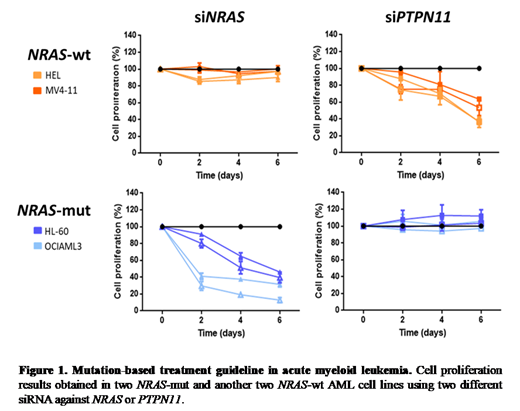Acute myeloid leukemia (AML) is a hematologic neoplasm characterized by a remarkable phenotypic and genomic heterogeneity. The recent characterization of genomic subtypes of AML based on large sequencing studies has provided the rationale for the development of targeted therapies based on the presence of specific genomic abnormalities. However, long term survival particularly in older patients remains a unmet medicalneed. Additionally, recent studies using RNA interference (RNAi) libraries have determined the existence of genes that are essential for the survival of multiple cancer cells. Understanding the effect of genomic alterations (mutations, deletions, translocations) on gene essentiality could favor the development of targeted therapies for specific subgroups of AML patients. However, current statistical methods such as the Benjamini-Hochberg (BH) procedure have shown limitations for controlling the false discovery rate (FDR) and have suboptimal sensitivity (recall of true positives) because the P-value correction does not include any prior information of individual tests.
For this reason, in this study we developed a new large-scale statistical algorithm, which combine the RNAi libraries (more than 17.000 genes) data with mutational profiles, to identify gene essentialities associated with specific genomic mutations in order to explore this approach in AML. We adapted the Independent Hypothesis Weighting (IHW) procedure to the problem of identifying mutations as surrogate markers of gene essentiality, by using the gene mutation state in each cell line as prior information of a IHW problem. This approach was tested in 19 tumor subtypes, of the Cancer Cell Line Encyclopedia (CCLE) showing that it recalls new discoveries that cannot be identified with standard procedures in 17 out of 19 tumors, including the identification of up to 1,000 discoveries in tumor types in which BH recalls no discovery. These results demonstrated the accuracy of the IHW-based approach to identify gene mutations as surrogate markers of gene essentiality in the future.
Once validated, we applied this computational model to the15 AMLcell lines of CCLE. The number of discoveries with an FDR of 20% increases from 2 (using the traditional BH correction), to 38 using our procedure, showing NRAS as the top mutation biomarker in the ranking. Interestingly, the algorithm identified one essential gene (NRAS) for NRAS mutated (NRAS-mut) and another essential gene (PTPN11) for NRAS wild type (NRAS-wt) AML cells, covering all samples of AMLs. To validate this hypothesis, we examined the effect of two different specific siRNAs for each gene (siPTPN11 and siNRAS) on cell proliferation of four AML cell lines: two lines with NRAS-mut (HL-60 and OCIAML3) and two with NRAS-wt (MV4-11 and HEL). Downregulation of NRAS expression significantly decreases the cell proliferation only in the 2 NRAS-mutated AML cell lines. Whereas the inhibition of PTPN11expression produced an equivalent effect, but specifically in the 2 NRAS-wt AML cell lines (Figure 1). These results confirmed our predictions and showed the essential role of NRAS or PTNPN11 in AML cell lines either with NRAS mutated or wild type, respectively.
These results demonstrate that the application of our algorithm in the context of specific gene mutation not only may allow identification of directed therapies based on the mutation but can also define new gene essentialities amenable for targeted therapies providing new therapeutic strategies in patients with AML and potentially in other tumors.
Paiva:Amgen, Bristol-Myers Squibb, Celgene, Janssen, Merck, Novartis, Roche and Sanofi: Honoraria, Membership on an entity's Board of Directors or advisory committees; Celgene, Janssen, Sanofi and Takeda: Consultancy. San-Miguel:Amgen, Bristol-Myers Squibb, Celgene, Janssen, MSD, Novartis, Roche, Sanofi, and Takeda: Consultancy, Honoraria.
Author notes
Asterisk with author names denotes non-ASH members.


This feature is available to Subscribers Only
Sign In or Create an Account Close Modal